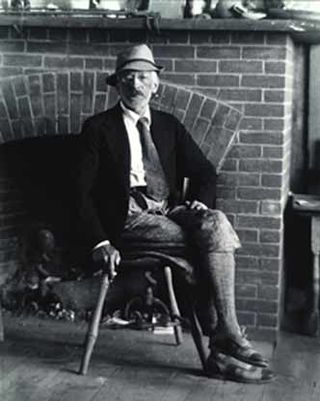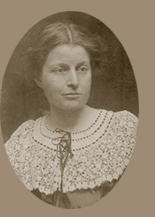
Henry Ossawa Tanner was an American artist who spent much of his career in France. He became the first African-American painter to gain international acclaim. Tanner moved to Paris, France, in 1891 to study at the Académie Julian and gained acclaim in French artistic circles. His painting Daniel in the Lions' Den was accepted into the 1896 Salon, the official art exhibition of the Académie des Beaux-Arts in Paris. Tanner's Resurrection of Lazarus was purchased by the French government after winning the third-place medal at the 1897 Salon. In 1923, the French government elected Tanner chevalier of the Legion of Honor.

Charles Herbert Woodbury, was an American marine painter.

Frank Weston Benson, frequently referred to as Frank W. Benson, was an American artist from Salem, Massachusetts known for his Realistic portraits, American Impressionist paintings, watercolors and etchings. He began his career painting portraits of distinguished families and murals for the Library of Congress. Some of his best known paintings depict his daughters outdoors at Benson's summer home, Wooster Farm, on the island of North Haven, Maine. He also produced numerous oil, wash and watercolor paintings and etchings of wildfowl and landscapes.

Harvey Thomas Dunn NA, also known as J. Harvey Dunn, was an American painter and teacher. During World War I, Dunn was an artist-correspondent with the American Expeditionary Forces in Europe. Most of Dunn's war sketches are housed at the Smithsonian Institution in the National Museum of American History in Washington, D.C. He is best known for his prairie-intimate masterpiece, The Prairie is My Garden (1950). In this painting, a mother and her two children are out gathering flowers from the quintessential prairie of the Great Plains.

The Art Academy of Cincinnati is a private college of art and design in Cincinnati, Ohio. It was founded as the McMicken School of Design in 1869, and was a department of the University of Cincinnati, and later in 1887, became the Art Academy of Cincinnati, the museum school of the Cincinnati Art Museum. The college is accredited by the National Association of Schools of Art and Design.
Gabriel Laderman was a New York painter and an early and important exponent of the Figurative revival of the 1950s and 1960s.

Soren Emil Carlsen was an American Impressionist painter who emigrated to the United States from Denmark. He became known for his still lifes. Later in his career, Carlsen expanded his range of subjects to include landscapes and seascapes as well.

Henry Hensche was an American painter and teacher.

Francis de Erdely was a Hungarian-American artist who was renowned in Europe and the United States for his powerful figure paintings and drawings as well as for his teaching abilities.

John Nelson Shanks was an American artist and painter. His best known works include his portrait of Diana, Princess of Wales, first shown at Hirschl & Adler Gallery in New York City, April 24 to June 28, 1996 and the portrait of president Bill Clinton for the National Portrait Gallery.
Carl Newland Werntz was an American painter, fine arts photographer, illustrator, cartoonist and educator who founded the Chicago Academy of Fine Arts. Werntz was a world traveler who was a proponent of Asian art and Japonisme. Through his own sketching and photographic expeditions to the American Southwest and his influence, he played an important role in the development of painting in the Southwest region in the early 20th century.
Lester Johnson was an American artist and educator. Johnson was a member of the Second Generation of the New York School during the late 1950s. The subject of much of his work is the human figure. His style is considered by critics and art historians to be in the figurative expressionist mode.

Louis Frederick Grell was an American figure composition and portrait artist based in the Tree Studio resident artist colony in Chicago, Illinois. He received his formal training in Europe from 1900 through 1915 and later became art professor at the Chicago Academy of Fine Arts from 1916 to 1922, and at the Art Institute of Chicago from 1922 to 1934. Grell exhibited his works throughout Europe from 1905 to 1915, in San Francisco in 1907, and in Chicago at the Art Institute 25 times from 1917 to 1941. He exhibited in New York in 1915 and 1916 and in Philadelphia and Washington DC. Primarily an allegorical and figurative composition muralist and portrait painter, his creative strokes adorn the ceilings and walls of numerous US National Historic Landmark buildings.

Abram Molarsky was an American Impressionist and Post-Impressionist artist, known primarily as a landscape painter and a colorist. His work is characterized by rich hues and strong, textured brushwork.

Helen Mary Knowlton was an American artist, art instructor and author. She taught in Boston from 1871 until the mid-1910s, when she was in her 70s. Her instructor and later employer, William Morris Hunt, was the subject of a portrait she made and several books; she is considered his principal biographer.

Anna Richards Brewster was an American painter.
John David Brcin was an American sculptor and artist.

William Peter Welsh (1889–1984) was a muralist, portrait painter, and illustrator from Kentucky as well as a soldier who served in both world wars and in the Mexican Border campaign with General Pershing in 1916. He died at age 95 in his hometown of Lexington, Kentucky. His mural painting Lexington Street Scene, October 1793 was at the Kentuckian Hotel on High Street and was recreated by the artist after its destruction and displayed at Hymon's Department store with prints also sold. His painting "Prisoner of War" is part of the Art Institute of Chicago's collection. He also painted murals for the Chicago Room of Palmer House and did a series of European style poster advertisements for Pullman sleeping cars. He won awards and recognition for the campaign. He worked in Illinois. His work was also part of the painting event in the art competition at the 1936 Summer Olympics.
Frances Julia Farrand Dodge was an American artist and teacher.














